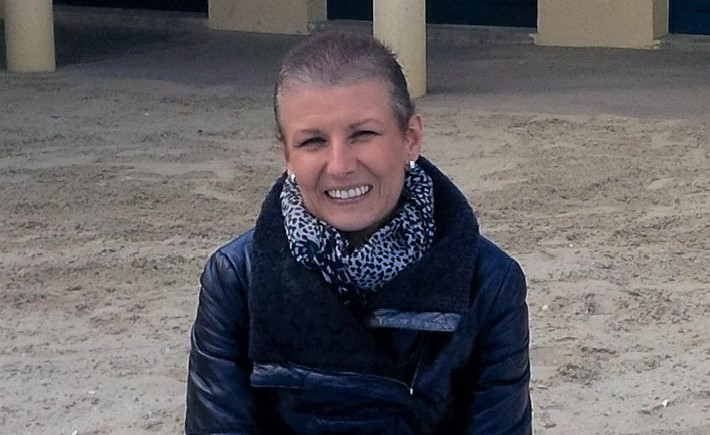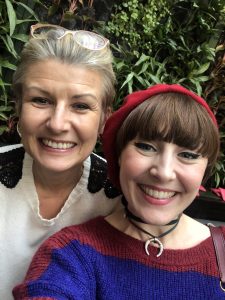

When cancer causes hair loss….

Feeling beautiful in spite of alopecia
Hair loss is one of the frequent and feared side effects of chemotherapy. My oncologist had warned me that the hair loss would start fourteen days after the first injection, and he was right.
I will always remember that Saturday morning. In the shower, I saw the first tufts of hair at my feet. Despite taking the greatest care, when massaging my scalp, strands of hair would come out by the handful and remain in the palm of my hands. What I feared so much was happening and I was powerless to do anything about it.
Alopecia is a way of “revealing the disease” it exposes the battle we are waging to everyone. This face without hair, eyelashes or eyebrows, generates various reactions in others, from fear to embarrassment or pity. Hair loss is a particularly painful experience for women. Hair has strong symbolic value and its loss is experienced as an attack on our femininity.
In my family, hair is important. From mother to daughter, we all have, long, straight, brown hair.
My mother was by my side when I decided to shave off what little I had left at the hair clinic.
To escape the unwanted looks from others which are difficult to bear or to preserve what we love, but also to try to live better with the disease, to try to enjoy it at least not to get lost, not to give up, many women use a hair prosthesis. These come in a large range of prices. They are covered by the French Social Security System of up to 125 euros (in April this year, the reimbursement will increase to 350 euros), and some complementary insurance companies in France cover all or part of the remaining costs.
 After shaving my hair off, the hair technician was quick to get me to try several wigs. Without success. I did not recognize myself, it was too brutal, and I was not ready. She then offered me turbans to cover my bald scalp, it was the middle of winter, and it was so cold… When I discovered these pretty models, I took pleasure in trying them on and observing myself, I thought they would be fashion accessories to enhance my outfits, a way to continue to take care for myself and keep in touch with this part of my femininity. I am fortunate enough to have the financial security that allowed me to buy several, but not all women can afford it because unfortunately the cost of turbans and scarves are not covered by the French Social Security.
After shaving my hair off, the hair technician was quick to get me to try several wigs. Without success. I did not recognize myself, it was too brutal, and I was not ready. She then offered me turbans to cover my bald scalp, it was the middle of winter, and it was so cold… When I discovered these pretty models, I took pleasure in trying them on and observing myself, I thought they would be fashion accessories to enhance my outfits, a way to continue to take care for myself and keep in touch with this part of my femininity. I am fortunate enough to have the financial security that allowed me to buy several, but not all women can afford it because unfortunately the cost of turbans and scarves are not covered by the French Social Security.
However, it should be noted, there has been a great advance using “mixed systems” which are covered by French Social Security, the first of which was created and patented by Julie, founder of Les Franjynes, a young and fantastic “cancer survivor”, which combine thermoregulatory turbans and hair. I would have loved to have had that at the time.
In addition, from April 2019, women who do not wish to have a hair prosthesis will be able to benefit from three accessories, paid for by the French Social Security including at least one textile accessory (scarf, turban, hair crown, bangs/fringe…).
Take care of your scalp to promote regrowth
Without hair, the skin of the very sensitive scalp is bare, without protection. Wearing wigs, caps, and hats weakens the scalp and causes discomfort such as irritation and itching. It is important to take care of it daily and protect it in the same way that we protect the skin on our face and body.
During the illness, I learned to take care of my scalp as much as my face or hands and to protect it from external aggression (pollution, cold, wind, etc.). I cleaned and hydrated it as much as I could with products that were not intended for this specific use. They were too greasy or too liquid, or irritating and their ingredients were too often unsuitable.
That is why I wanted the Laboratoire Ozalys to develop a gentle scalp milk that instantly soothes, moisturizes and prepares the hair for regrowth. I called it Reconciling, because looking at this face of “death” in the mirror is such a hard challenge. Reconciling yourself with this image by taking care of yourself helps to contribute to restoring your self-esteem…
After the treatments (about six weeks after the last chemotherapy session), the long-awaited moment of hair growth finally arrived. Often shy and fragile, the first hairs must be treated with great care and caution. They are often different from the ones we had before, the color and texture can change. In addition, very surprisingly, regrowth causes itching too!
This step is often a sign of good health and recovery in the eyes of our loved ones, but we “cancer survivors” know that “the after cancer” is not that simple.
My entourage dreamed of seeing me as I was before, with my long brown braid or my “crazy” bun. But, this image no longer matched the woman I had become and the image I had of myself. Then, one day, without saying anything to anyone, I went to my hairdresser and came out with short-cut, platinum blonde hair! As we often say, “new cut, new chapter”.
Because I know that hair is put to the test during the illness but also afterwards, through anti-hormonal treatments, I wanted Ozalys to also offer a Shampoo that meets all your needs in one treatment. Because life is precious, and beauty too.

